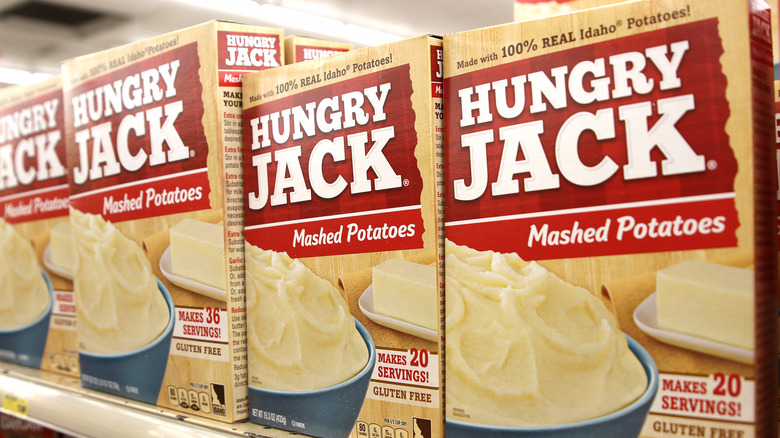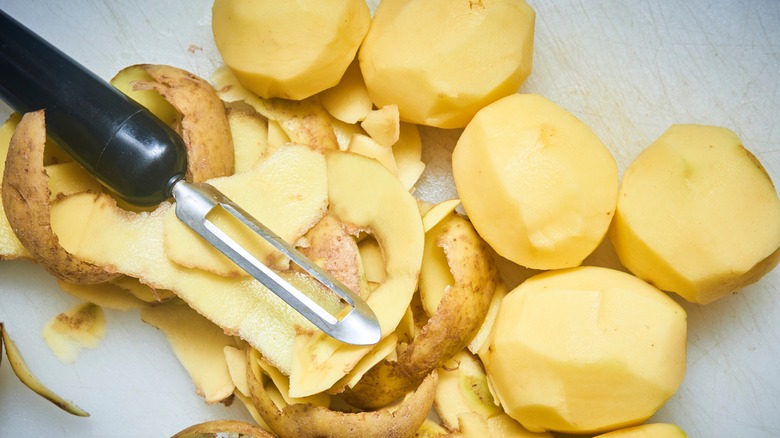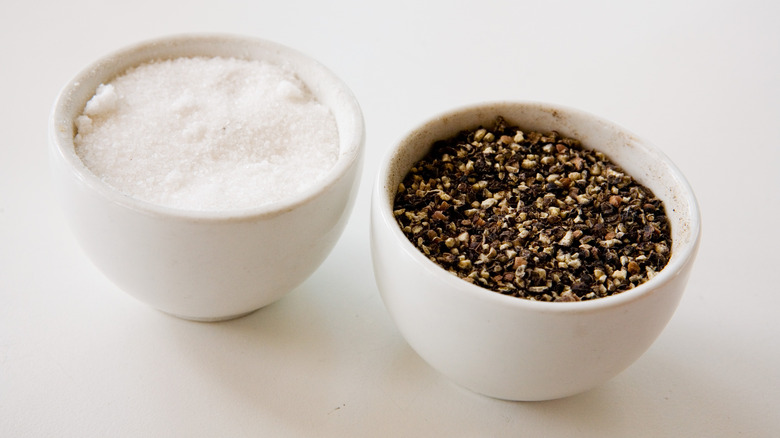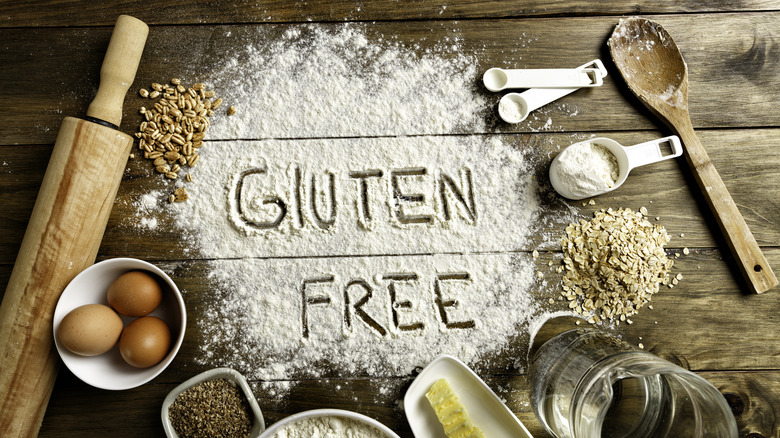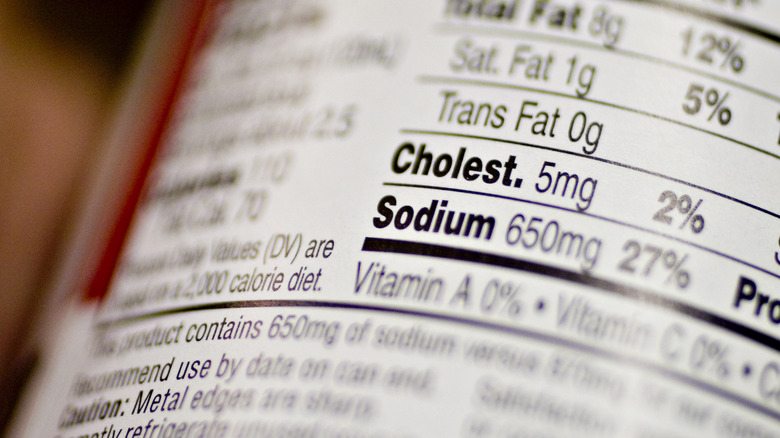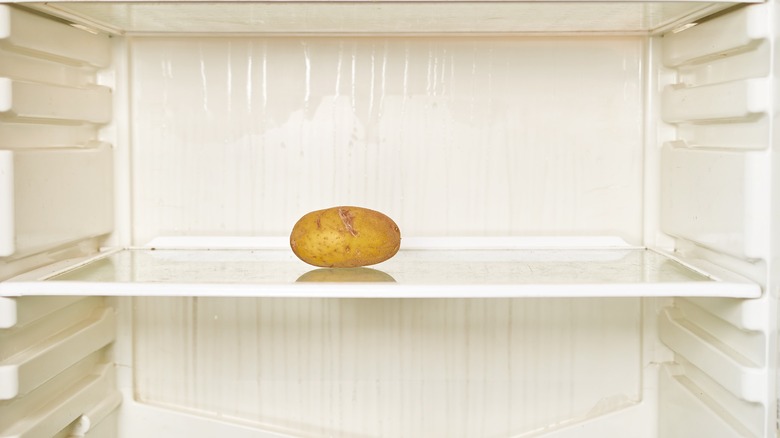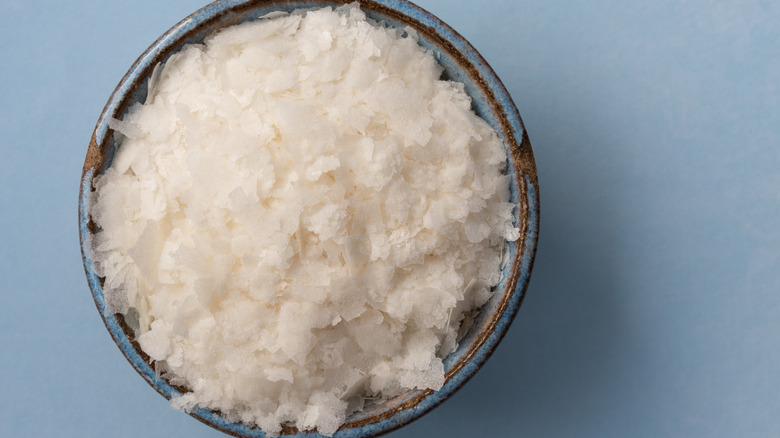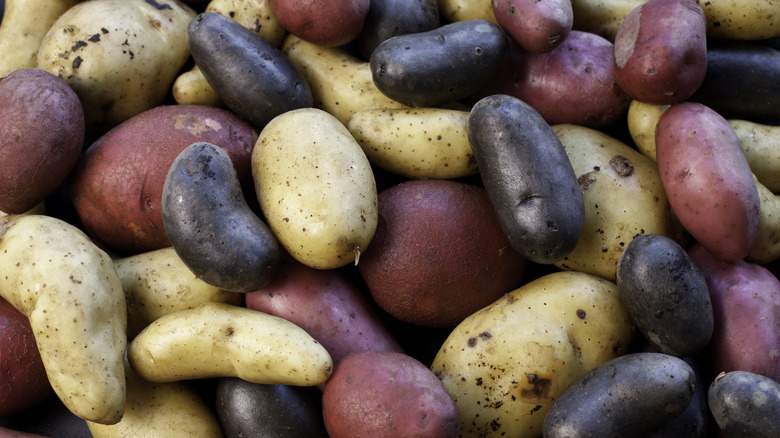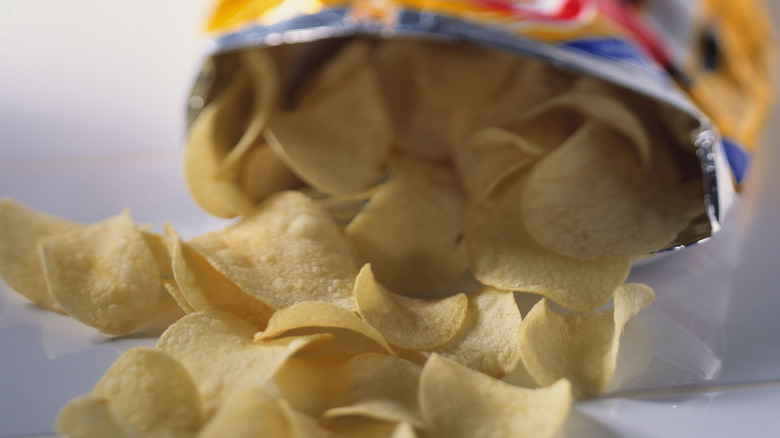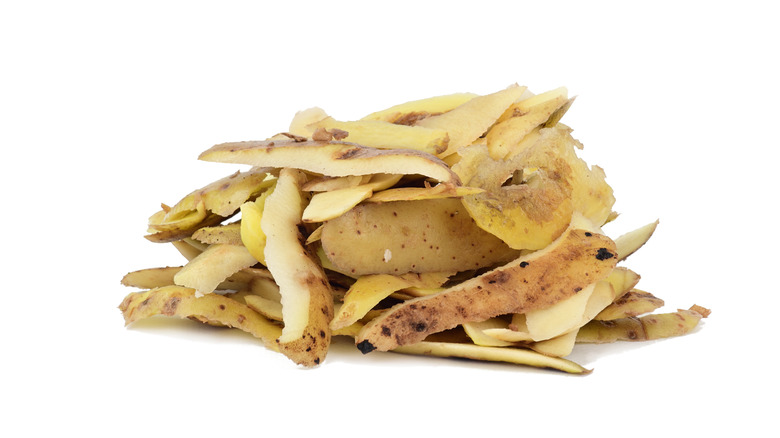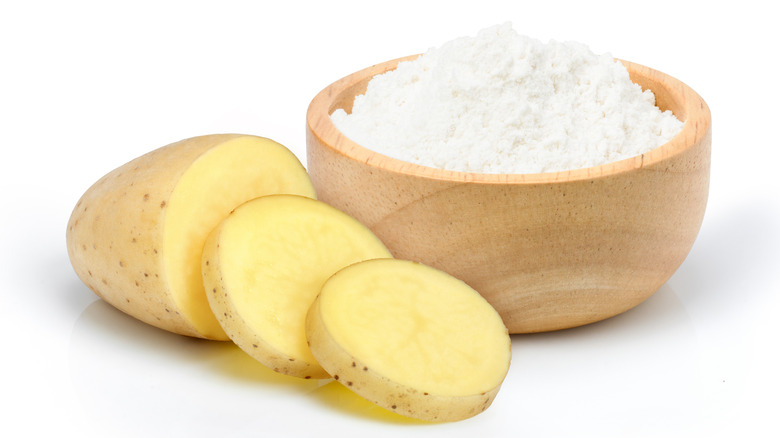Here's How Instant Potatoes Are Really Made
Instant potatoes are often thought of as fake, over-processed food with little nutritive value. That doesn't stop people from eating them, and it's very easy to overeat and turn a mashed-potato side into the primary calorie source of your meal. If you're trying to clean up your diet, cutting back on instant potatoes might sound like an obvious choice.
But not so fast. While there are versions of instant potatoes that are high in sodium and fat, there are also versions that have simple ingredient lists that fit well in healthy diets. Instant potatoes themselves are made from real potatoes using a process that isn't especially complicated overall, and they contain more nutrition than people give them credit for. Take a look at how instant potatoes are made, and you'll see that this convenience food deserves a permanent place in your pantry.
At their most basic, they're just mashed and dried potatoes
Out of all the processed and premade foods you can buy, instant potatoes probably rank among the most basic of the lot. While commercial preparation methods sound complicated when you look at the fine details, in a nutshell, instant potatoes are boiled, peeled, mashed, dried, broken up, seasoned, and boxed. Sure, you could find heavily processed brands that have longer ingredient labels, but plain instant potatoes are generally going to have a rather short ingredient list.
While you'll find some sources that say uncooked potatoes are used for instant potatoes, most of what you'll find at a store got its start as boiled or precooked potatoes. That's why rehydrating them is so easy; you're only restoring cooked food to a non-dehydrated state. However, freeze-dried potatoes are another matter — while those tend to be made with cooked potatoes, you may also find some freeze-fried potatoes that require cooking once rehydrated.
Flavoring comes from the drying process, among other means
Instant potatoes get their flavor in a few ways. They retain some flavor during the drying process, and technology on this front has definitely improved over the years. The cooking and dehydration process is short enough now to keep a lot of that potato flavor in the dehydrated product, which was not always the case — the American Chemical Society said that back in the 1940s, for example, dehydrated foods didn't have much going for them in the way of flavor.
That's changed these days, not only because the shorter processing time removes less flavor, but also because producers may now choose to include bits of the peel, according to the Idaho Potato Commission. Producers also add salt, pepper, powdered buttermilk, and other spices to the dry mix, too, such as when they produce garlic- or butter-flavored instant potatoes. As with other processed and premade foods, instant potatoes with flavorings can be high in sodium. If that's a concern, buy plain instant potatoes and add your own seasonings.
Potatoes are gluten-free, but instant potatoes might not be
If you have celiac disease or any other condition that requires you avoid gluten, potatoes are a great choice for the carb portion of your meals. Potatoes themselves have no gluten. However, instant potatoes may not be as safe because the processing they go through could put them in touch with traces of gluten. If the dehydrated potatoes are made with the same equipment that recently produced a batch of wheat bread, for example, there could be some cross-contamination if the equipment wasn't cleaned thoroughly. And there's always the chance that, somewhere along the line, the potatoes were exposed to wheat flour or another gluten product through the inclusion of flavoring or other additives.
This doesn't mean that you can't have instant potatoes if you're avoiding gluten. It simply means that you need to look for gluten-free varieties, which isn't as difficult as you think. Major brands usually have gluten-free versions of their signature products whenever possible, and instant potatoes are no exception.
The dried form affects the final cooked form
Once the potatoes have been cooked, mashed, and dried, they have to be broken up. The final product can take several forms, including flakes, granules, pearls, powder, and even little cubes. That final form heavily influences the final reconstituted product, so if you have a preferred texture for mashed potatoes, sample a few brands and forms to find the one that rehydrates to that texture. Flakes and larger granules, for example, create a texture similar to that of freshly made mashed potatoes, but granules that are too finely ground produce pasty mashed potatoes.
If you end up with a box of instant potatoes that don't rehydrate the way you'd like, don't throw it out. You can use the contents in recipes that call for mashed potatoes as fillers or even as a main carb. For example, bread loaves and rolls made with mashed potatoes are delicious; you can even make a pastry dough with mashed potatoes. If you ever want to make some bread and find you don't have enough flour, those instant potatoes may be just what you need to complete the recipe.
Potatoes retain most of their nutrition during the drying and recooking process
Mashed potatoes don't have a reputation as a very nutrient-dense food. They're often seen as a mushy, carby, calorific addition to a meal, and they certainly can be if you add too much butter or eat too large a portion. But instant mashed potatoes actually don't lose that much in the way of nutrition during the cooking and drying processes. There is some loss — removing the peel removes some fiber, and the heat involved in cooking and drying destroys much of the vitamin C that's naturally found in fresh potatoes. For example, a 2006 study found that reconstituted mashed potatoes held in a steam table for a half hour lost nearly 96% of the vitamin C content.
But otherwise, the nutrient value of instant potatoes is close to that of fresh potatoes because most nutrients aren't destroyed by dehydration. Vitamin C can be added back in if the potatoes are fortified after they've been dried. But again, adding too much butter, cream, salt, and so on dilutes that nutrient profile.
They need an additive to extend their shelf life
As shelf stable as instant potatoes can be, they aren't invincible or immortal. They can spoil, and even under the best storage conditions, a typical box of instant potatoes won't last long without an additive called sodium acid pyrophosphate, or SAPP. The name sounds like something out of a mad scientist's lab, but it's a food product derived from food-grade phosphoric acid. It's an all-around additive that helps with rising, flavoring, preserving color, and even reducing the production of acrylamide in fries. It's also called disodium diphosphate and is part of what gives baking powder its rising power.
Sodium acid pyrophosphate's role in instant potatoes is mainly as a color-preserving agent. Potato flakes contain iron, which can cause discoloration over time. SAPP blocks this discoloration, maintaining a whiter color in the flakes and granules. The potatoes will still fade in quality eventually, but SAPP helps them stay usable for a lot longer than they'd be without it.
The invention of the potato flake involved a few different institutions
The invention of instant potatoes took a few different routes to reach its destination. Dehydrated potatoes themselves were not new at the dawn of the 20th century — there's evidence that the Incas used to dry and powder potatoes as a way to preserve food — but early 20th century dehydrated potatoes just weren't very good. In 1905, Ernest W. Cooke (what a great example of nominative determinism) patented a process that involved cutting up potatoes, cooking them, and then drying them in a way that allowed them to be rehydrated quickly and without creating much of a mess. Cooke's process preserved the cell walls in the potato, which helped give the final rehydrated product a relatively appealing texture. Unfortunately, previous dehydrated potatoes were so bad that this wasn't that much of an improvement. Cooke's version didn't become a favorite food, although it did travel well as part of wartime food supplies.
By the late 1940s, the U.S. Department of Agriculture had set up a research center in the Western U.S. to work on recipes for potato granules. Around the onset of the 1950s, the R.T. French Company used a British patent for dehydrated potatoes to create instant potato granules that rehydrated much more easily into a better-tasting potato mix. In the 1960s, Canadian scientist Edward Asselbergs created another process to produce flakes instead of granules. And in Philadelphia, the USDA set up another research center in the early 1950s that also looked at ways to dehydrate potatoes to create instant, shelf-stable flakes.
Research into the flaking process allowed more potatoes to go instant
When instant potatoes were first made, they used high-solid varieties like russets — Western varieties that didn't grow well in the Eastern half of the U.S. That meant the supply of instant potatoes was limited to what states like Idaho could produce. The USDA's Philadelphia research team, however, created a three-step process (called, of course, the Philadelphia Cook) that could take potato varieties grown in the Eastern half of the country and dehydrate them just as well as the Western varieties. This discovery allowed many more cultivars to be used for instant potatoes and allowed more states to provide potatoes for dehydration.
Interestingly, Miles Willard, one of the men who helped create those potato flakes in Philadelphia, ended up moving to Idaho to design a commercial potato flake factory. Among the products he created were chips made from potato flakes, which were eventually sold commercially. One of those potato-flake chip products was Pringles.
Low peel, low leach dehydrated potatoes aren't for home use
Instant potatoes that you see on store shelves come in forms like flakes, pearls, and granules, but there's another type that you aren't going to find in a box at the store. These are low peel and low leach dehydrated potatoes, which go through reduced processing. "Low peel" refers to a reduced amount of peeling; these potatoes still have a light layer of peel on them when they're dried and pulverized so that the final product has more potato flavor than standard flakes and granules. The reduced processing also results in less starch getting leached out, and while starchy potatoes are usually good for mashing, in this case, there could be too much starch in the final powder.
While low peel, low leach dehydrated potatoes aren't good to use as standard instant potatoes, they're a boon for snack producers. Not only does the powder form a dough that producers can use to make potato snacks (or "fabricated potato snack products," according to Potatoes USA), but the powder itself lends texture and taste to other baked products, like cookies.
Potato flakes use up wasted potato parts
If you eat baby carrots (we'll get back to the potatoes in a second), you likely know those actually aren't real baby carrots plucked out of the ground when they're young; they're pieces of regular carrots that were shaped to look like smaller versions, and you likely know that the carrots used were deemed too misshapen or broken to be sold as they were. A California-based farming family hated throwing away so many carrots just because they looked odd, so the family came up with a way to shave down the rejected bits into these baby-sized carrots. It's a great way to use up food that would normally be considered waste.
Instant potatoes often use food that's in a similar state. Potatoes that are smaller than normal and pieces of potatoes left over from making other products like chips end up sources of potato granules and flakes. The potatoes and leftover chip pieces are perfectly edible but not fit for sale or further use as they are, so sending them to become instant potatoes is an efficient way to use up as much of these potatoes as possible.
Potato flakes and potato flour are made in almost the same way
Now that you know how instant potato flakes and granules are made, guess what? You also know how potato flour is made. Potato flour is dehydrated mashed potatoes put through some extra grinding to turn them into a fine powder. This is why, when you make recipes that call for potato flour, you can often substitute potato granules or flakes, or even non-dehydrated mashed potatoes. It's all the same stuff in different forms.
What potato flour isn't, is potato starch. That's a byproduct of crushing raw potatoes, which releases a liquid that is then dried. You can't use instant potatoes in place of potato starch or vice versa, but you can use potato starch in place of cornstarch and other powdered thickeners. There are recipes that call for thickening sauces and soups with mashed or instant potatoes, but those don't thicken in exactly the same way that starch does. Instant potatoes absorb liquid and thus can make a mixture seem less watery — and no doubt the starch contained in the potatoes helps — but pure starch gelatinizes when cooked with liquid.
You can make your own instant potatoes
If you're not thrilled with the list of ingredients in commercial instant potatoes, you can make your own with a food dehydrator. The procedure is simple: Boil the potatoes, peel them, mash them very well, spread them out in a very thin layer on a tray, and stick them in the dehydrator. Exact temperatures and drying times vary by recipe but expect to wait anywhere from eight to 20 hours, especially if you want to make potato flour. When the potatoes are completely dry, either break the layer into pieces or grind the potatoes into granules. Writing on the subject, home economist Getty Stewart said that when the potatoes are dry enough, they'll be brittle; if they bend, they aren't ready. And she outright warned against adding any sort of butter, milk, or other fat, which will interfere with dehydration and make the potatoes turn rancid.
By the way, definitely use a dehydrator; while it's possible to dry food on a rack in the sun, potatoes (and other vegetables) aren't a good candidate. Sun drying takes a very long time (days!), and the low acidity of potatoes makes them prone to spoilage during the process. Keep in mind that for long-term storage, most instant potatoes have to have additives like sodium acid pyrophosphate, and even then, they may last no more than two years. For longer storage, you'll have to look into processes favored by emergency preppers, which involve mylar bags or special cans.
